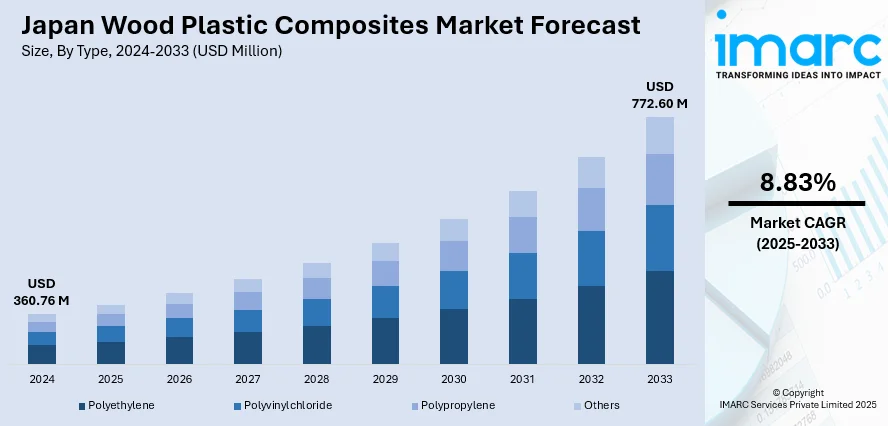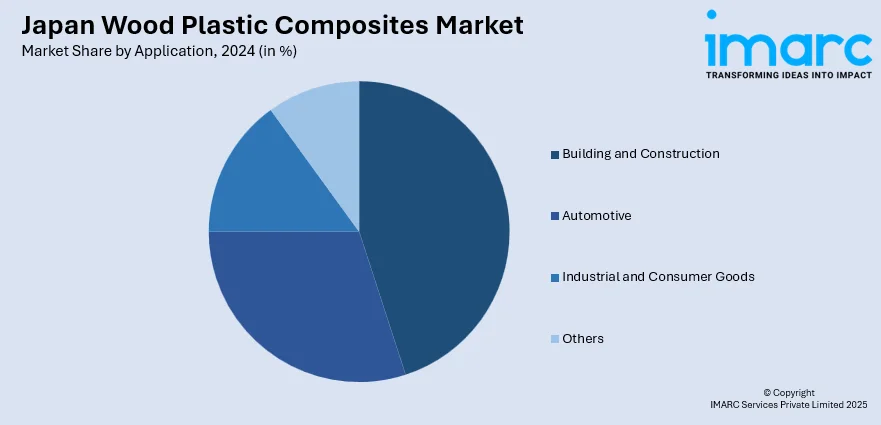
Japan Wood Plastic Composites Market Size, Share, Trends and Forecast by Type, Application, and Region, 2025-2033
Japan Wood Plastic Composites Market Overview:
The Japan wood plastic composites market size reached USD 360.76 Million in 2024. Looking forward, IMARC Group expects the market to reach USD 772.60 Million by 2033, exhibiting a growth rate (CAGR) of 8.83% during 2025-2033. The increasing demand for eco-friendly materials, government regulations promoting sustainable construction, advancements in WPC technology, rising consumer awareness of environmental impact, and the expanding use of WPC in various industries such as construction, automotive, and furniture are contributing to the market growth.
|
Report Attribute
|
Key Statistics
|
|---|---|
|
Base Year
|
2024
|
|
Forecast Years
|
2025-2033
|
|
Historical Years
|
2019-2024
|
| Market Size in 2024 | USD 360.76 Million |
| Market Forecast in 2033 | USD 772.60 Million |
| Market Growth Rate 2025-2033 | 8.83% |
Japan Wood Plastic Composites Market Trends:
Rising Demand for Eco-Friendly and Sustainable Building Materials
A key trend driving the growth of the Japan wood plastic composites (WPCs) market is the increasing demand for eco-friendly and sustainable building materials. As environmental concerns intensify, the Japanese construction industry is turning to materials that reduce carbon footprints, are recyclable, and have minimal environmental impact. WPCs, made from a blend of wood fibers and plastic, serve as a viable alternative to traditional materials like timber and concrete, offering the aesthetic appeal of wood while being more durable, weather-resistant, and low-maintenance. These composites are especially favored for decking, cladding, fencing, and other outdoor applications due to their resistance to water, rot, and pests. Furthermore, Japan's growing focus on a circular economy, with an emphasis on using recycled plastics, aligns well with the adoption of WPCs. With the government enacting stricter regulations to reduce greenhouse gas emissions, the demand for sustainable building materials in Japan is projected to increase considerably in the near-term.

Technological Advancements in Wood Plastic Composite Production
Technological advancements in WPC production are significantly driving the growth of the Japan wood plastic composites market. Innovations in manufacturing processes, such as extrusion and injection molding, have enhanced WPCs' quality, performance, and versatility. The development of advanced additives and formulations has improved their durability, UV resistance, color retention, and wear resistance. Moreover, the integration of nanotechnology is boosting the mechanical properties of WPCs, including strength, impact resistance, and longevity. This has expanded their applications beyond construction to industries like automotive, furniture, and consumer goods. The rise of 3D printing in WPC production has further enhanced design flexibility, allowing manufacturers to create customized products that meet specific functional and aesthetic demands. These technological advancements have made WPCs more cost-competitive compared to traditional materials, contributing to their growing market share in both residential and commercial construction sectors.
Japan Wood Plastic Composites Market Segmentation:
IMARC Group provides an analysis of the key trends in each segment of the market, along with forecasts at the region/country level for 2025-2033. Our report has categorized the market based on type and application.
Type Insights:
- Polyethylene
- Polyvinylchloride
- Polypropylene
- Others
The report has provided a detailed breakup and analysis of the market based on the type. This includes polyethylene, polyvinylchloride, polypropylene, and others.
Application Insights:

- Building and Construction
- Automotive
- Industrial and Consumer Goods
- Others
A detailed breakup and analysis of the market based on the application have also been provided in the report. This includes building and construction, automotive, industrial and consumer goods, and others.
Regional Insights:
- Kanto Region
- Kansai/Kinki Region
- Central/Chubu Region
- Kyushu-Okinawa Region
- Tohoku Region
- Chugoku Region
- Hokkaido Region
- Shikoku Region
The report has also provided a comprehensive analysis of all the major regional markets, which include Kanto Region, Kansai/Kinki Region, Central/Chubu Region, Kyushu-Okinawa Region, Tohoku Region, Chugoku Region, Hokkaido Region, and Shikoku Region.
Competitive Landscape:
The market research report has also provided a comprehensive analysis of the competitive landscape. Competitive analysis such as market structure, key player positioning, top winning strategies, competitive dashboard, and company evaluation quadrant has been covered in the report. Also, detailed profiles of all major companies have been provided.
Japan Wood Plastic Composites Market News:
- December 2024: LIXIL commenced mass production of "Revia", a recycled material that combined almost all types of waste plastic, including composite plastics, at its Hisai Plant in Mie Prefecture. Revia combines hard-to-recycle waste plastics with waste wood, reducing CO₂ emissions by approximately 82% compared to incineration.
- April 2024: The Japan Wood-Products Export Association secured U.S. certification for hinoki two-by-four lumber, paving the way for broader exports of the hinoki cypress as well as sugi cedar, renowned for their strength and aromatic qualities. This initiative aligns with global sustainability trends, promoting materials like wood-plastic composites, which blend wood waste with recycled plastics to create durable, eco-friendly products for construction and automotive industries.
Japan Wood Plastic Composites Market Report Coverage:
| Report Features | Details |
|---|---|
| Base Year of the Analysis | 2024 |
| Historical Period | 2019-2024 |
| Forecast Period | 2025-2033 |
| Units | Million USD |
| Scope of the Report |
Exploration of Historical Trends and Market Outlook, Industry Catalysts and Challenges, Segment-Wise Historical and Future Market Assessment:
|
| Types Covered | Polyethylene, Polyvinylchloride, Polypropylene, Others |
| Applications Covered | Building and Construction, Automotive, Industrial and Consumer Goods, Others |
| Regions Covered | Kanto Region, Kansai/Kinki Region, Central/Chubu Region, Kyushu-Okinawa Region, Tohoku Region, Chugoku Region, Hokkaido Region, Shikoku Region |
| Customization Scope | 10% Free Customization |
| Post-Sale Analyst Support | 10-12 Weeks |
| Delivery Format | PDF and Excel through Email (We can also provide the editable version of the report in PPT/Word format on special request) |
Key Questions Answered in This Report:
- How has the Japan wood plastic composites market performed so far and how will it perform in the coming years?
- What is the breakup of the Japan wood plastic composites market on the basis of type?
- What is the breakup of the Japan wood plastic composites market on the basis of application?
- What is the breakup of the Japan wood plastic composites market on the basis of region?
- What are the various stages in the value chain of the Japan wood plastic composites market?
- What are the key driving factors and challenges in the Japan wood plastic composites market?
- What is the structure of the Japan wood plastic composites market and who are the key players?
- What is the degree of competition in the Japan wood plastic composites market?
Key Benefits for Stakeholders:
- IMARC’s industry report offers a comprehensive quantitative analysis of various market segments, historical and current market trends, market forecasts, and dynamics of the Japan wood plastic composites market from 2019-2033.
- The research report provides the latest information on the market drivers, challenges, and opportunities in the Japan wood plastic composites market.
- Porter's five forces analysis assist stakeholders in assessing the impact of new entrants, competitive rivalry, supplier power, buyer power, and the threat of substitution. It helps stakeholders to analyze the level of competition within the Japan wood plastic composites industry and its attractiveness.
- Competitive landscape allows stakeholders to understand their competitive environment and provides an insight into the current positions of key players in the market.
Need more help?
- Speak to our experienced analysts for insights on the current market scenarios.
- Include additional segments and countries to customize the report as per your requirement.
- Gain an unparalleled competitive advantage in your domain by understanding how to utilize the report and positively impacting your operations and revenue.
- For further assistance, please connect with our analysts.
 Request Customization
Request Customization
 Speak to an Analyst
Speak to an Analyst
 Request Brochure
Request Brochure
 Inquire Before Buying
Inquire Before Buying




.webp)




.webp)












